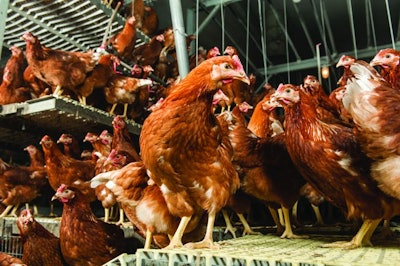
A longstanding myth in egg production is that interventions to boost performance should be introduced only once a hen becomes productive. Overlooking the pullet period as a platform for longer, more productive flocks, however, can harm flock performance and profitability.
Investments in pullets support business, contrary to the myths that surround the pullet phase.
Myth 1 – Least-cost feed formulation – the best pullet choice
A least-cost formulation mindset produces the cheapest feed that meets a specific criterion, but it may not fully prepare a bird for lay. Another way to think about pullet diets is to formulate for maximum profit across the bird’s life.
This is the difference between feeding a bird to become an 18-week-old hen, or feeding towards a point-of-lay hen with the nutrient reserves needed for sustained, high levels of egg production.
Myth 2 – Nutrition becomes a priority only once laying starts
Neglecting pullet nutrition can lead to variable flocks and birds that are underweight or unable to consume sufficient feed when lay starts, resulting in quicker productivity declines. Additionally, poor early nutrition can harm long-term skeletal health and eggshell quality.
Myth 3 – Weight is more important than body composition
Focusing on correct body condition – not simply on weight gain – helps to ensure that the bird is well developed for laying and has apportioned nutrients to support long-term skeletal health and shell quality.
A well-developed bird will have deposits of medullary bone before lay starts. Reserves deposited in bone are essential to eggshell development, but they deplete over time.
Adding too much weight late in the pullet period typically only puts fat on the bird. Overweight birds can lay over-large eggs and have shell quality problems at end of lay.
Myth 4 – Age should drive diet adaptations
Feeding instructions based on bird age are guidelines using assumptions that may not reflect individual flocks.
Multiple factors, including stress, can reduce feed intake. Following stress, it may even be necessary to put birds briefly on a more nutritionally dense feed until daily intake returns to normal.
Bodyweight and flock uniformity should be regularly monitored in growing birds to ensure that no problems are developing. It is easier to correct bodyweight issues earlier on, when subtle interventions often suffice.
Myth 5 – Photo-stimulation should never be delayed
Many producers are reluctant to delay photo-stimulation, thinking that they will lose eggs.
However, ensuring that a bird has the nutritional reserves required for long-term productivity contributes to a longer lay. Underprepared birds can start lay on time but then suffer a rapid production drop as problems emerge.
Myth 6 – Birds can’t be trained to eat
Training provides major benefits. Particularly in automated barns, it can be a straightforward process to implement a stack feeding program and teach birds to eat using stacked timing with additional feeding shifts added as birds age.
Not all flocks react in the same way, however, and the response to changing feeding programs must be carefully evaluated.
Diet ingredients also can be used to help prepare birds to eat more – adding 3-4% fiber to pullet diets and up to 7% in developer diets, along with providing coarse fiber, can improve gizzard size, gut microflora and litter quality. Fibre increments should be made gradually, allowing the pullet to adapt to the change.
Myth 7 – Monitoring gut health is for broilers
Various phases in the life of laying hens come with significant risk of intestinal health challenges. These often chronic issues, such as the prevalent but poorly understood focal duodenal necrosis ("gray gut"), are frequently missed or deemed normal.
During this time, however, for birds to extract sufficient nutritional benefit from their feed is challenging. This leads, mostly, to reduced pullet growth and poor uniformity and in the case of laying hens to increased feed intake or lower production.
In pullets, the period between four and eight weeks of life is often challenging, with subclinical or even clinical coccidiosis and necrotic enteritis caused by some of the same pathogens found in broiler production.
Luckily, in pullet rearing it is in many cases possible to invest to catch up on missed growth or suboptimal uniformity.
This is one of the reasons why monitoring and frequent flock visits are valuable, including when there are no apparent problems. These visits, combined with preventively supporting birds when they may face intestinal heath challenges, prove a good recipe to achieve reliable and persistent laying flocks.

Managing key pullet, layer gut health challenges
www.WATTAgnet.com/articles/44318

















